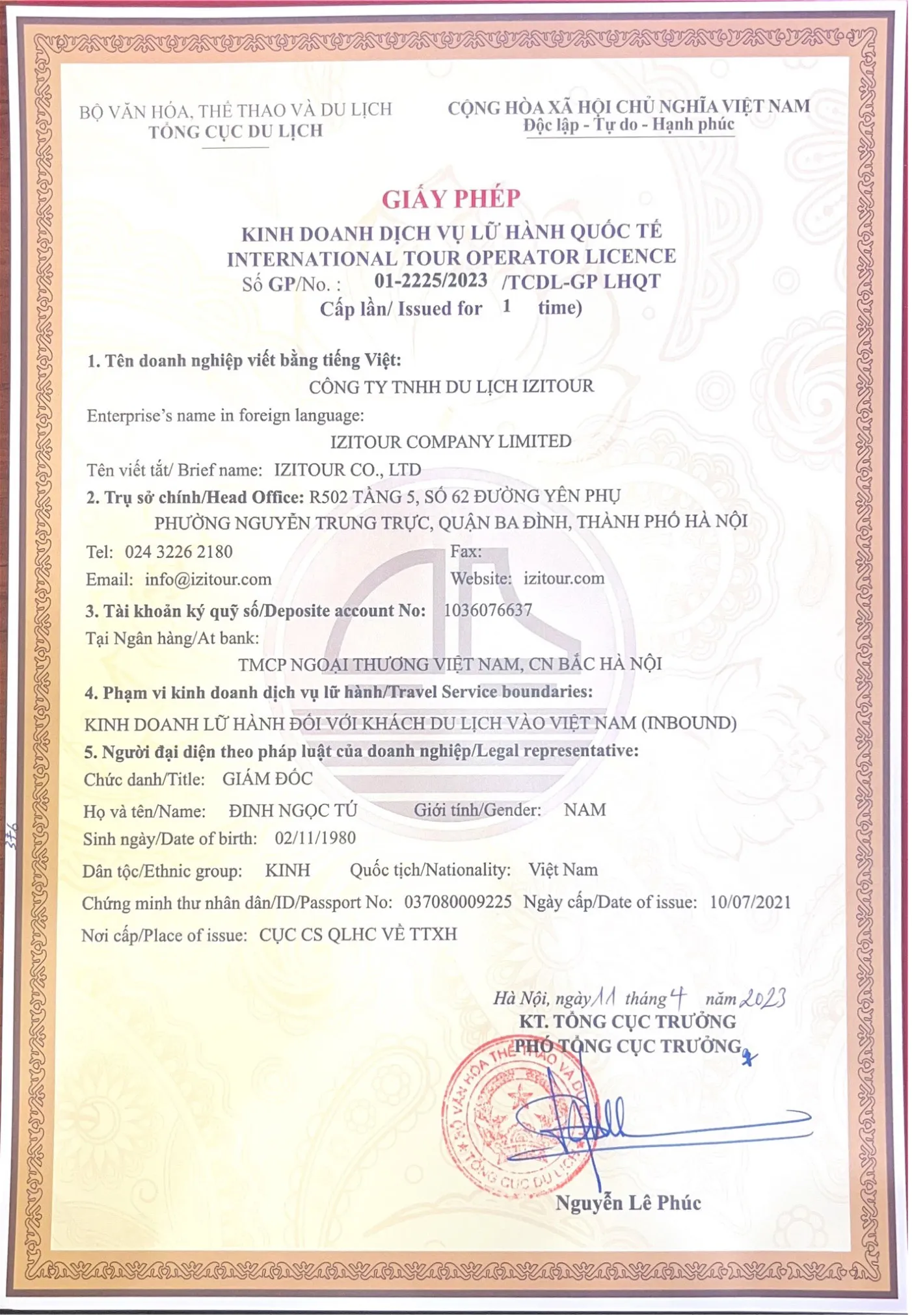Snake wine, also known as Snake Whiskey, is a traditional alcoholic beverage made by infusing whole snakes in rice wine or grain alcohol. Commonly found in Vietnam and other parts of Southeast Asia, this striking drink has long been associated with traditional medicine and folk beliefs, particularly in relation to strength, virility, and vitality. To many international travellers, snake wine is an exotic curiosity — something you might encounter in a street market or rural bar and wonder whether it’s real, safe, or simply a cultural novelty. Its appearance alone tends to raise questions, and often concerns.
This article takes a closer look at the cultural background, preparation methods, and the claims surrounding snake wine’s medicinal benefits. You'll also learn about potential health risks, and what to keep in mind if you're thinking about trying it yourself. The aim is to give you a well-rounded, objective understanding — so you can decide where snake wine fits into your cultural journey.
1. What is snake wine?
Snake wine is an alcoholic beverage that contains a whole snake — often venomous — soaked in rice wine or a strong grain alcohol. In Vietnam, it’s commonly known as rượu rắn. The visual impact is immediate: a coiled snake, sometimes accompanied by herbs or smaller animals like scorpions or geckos, floating in golden liquid inside a glass bottle.
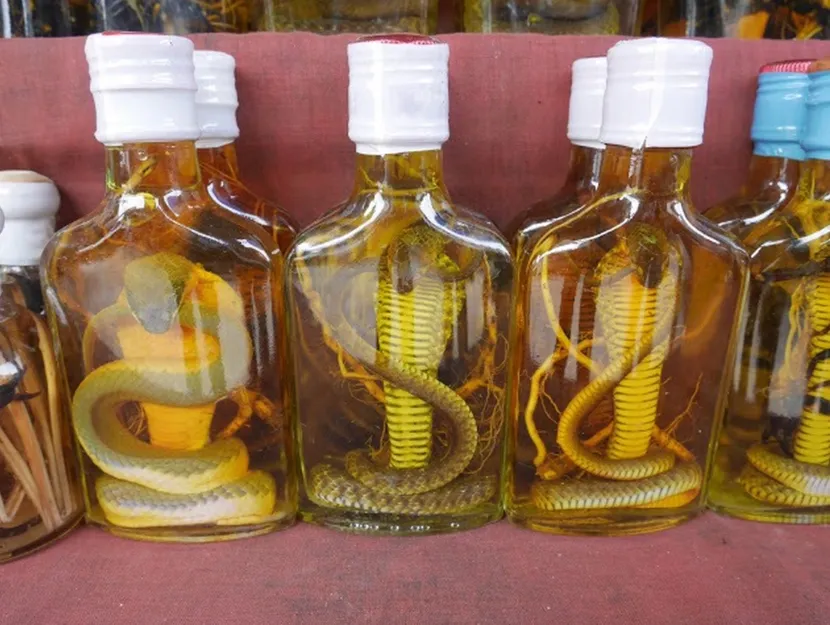
There are two main types of snake wine:
- Whole Snake Soaking (Maceration Method):
A complete, usually venomous, snake is placed into a jar or bottle of alcohol and left to steep for several months. The high alcohol content is believed to denature the venom, making the wine safe to drink.
- Snake Essence (Blood or Bile Mix):
In some cases, fresh snake blood or bile is mixed directly into alcohol and consumed immediately. This version is more controversial and often seen in very specific local or ceremonial contexts.
While both types are referred to as snake wine, their preparation and the intensity of their cultural significance can vary widely. Some versions are mass-produced and sold to tourists, while others are homemade and used in traditional households as a form of folk remedy.
Despite its striking appearance, snake wine is not primarily meant for intoxication. It’s traditionally consumed in small quantities — often a shot at a time — and valued more for its symbolic and supposed medicinal properties than for taste.
2. The history and cultural significance of snake wine
The roots of snake wine trace back over a thousand years, with its origins most commonly linked to traditional Eastern medicine. It later spread across Southeast Asia, including Vietnam, where local versions developed their own nuances and cultural associations.
In traditional Eastern medicine, snake wine is said to provide a “yang” balancing effect. According to this belief system, the body’s health depends on maintaining harmony between the opposing forces of yin (passive, cool, feminine) and yang (active, warm, masculine). Snake wine, believed to be warming and invigorating, is considered a strong source of yang energy. As such, it’s thought to restore balance in individuals with excess yin — often interpreted as fatigue, weakness, or poor circulation.
In Vietnamese tradition, snake wine is seen as a tonic — something that restores balance, boosts energy, and reinforces the body’s internal strength. It’s particularly associated with masculinity and virility, often believed to improve stamina and male sexual health. In some rural areas, it’s also considered a remedy for ailments such as back pain, arthritis, and digestive issues.
The choice of snake is not random. Venomous species like cobras are often used because they’re thought to carry more potent medicinal energy. The snake’s aggressive strength, once soaked into the alcohol, is believed to be transferred to the drinker — a concept rooted in the symbolic power of the animal rather than any scientific evidence.
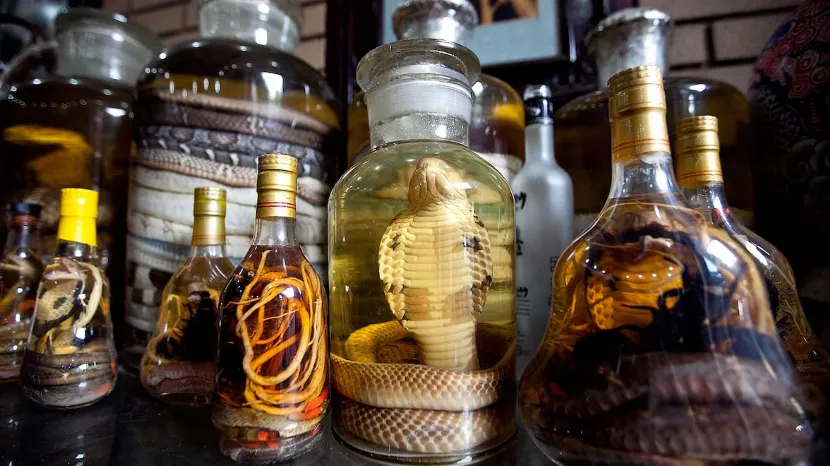
Photo: National Geographic
Snake wine is also tied to hospitality and ritual. In some households, a small glass might be offered to guests as a mark of respect or strength. In others, it may sit untouched, functioning more as a decorative or spiritual symbol than a beverage.
Though its use has declined somewhat in urban centres, snake wine remains embedded in traditional culture, especially in rural and mountainous regions. Today, it continues to attract interest from locals and curious travellers alike — as much for its historical mystique as for its distinctive appearance.
3. How is snake wine made?
The preparation of snake wine is steeped in tradition and varies slightly depending on region, purpose, and personal technique. However, most methods fall into one of two main categories: soaking or mixing. In both methods, especially the soaking technique, the alcohol’s strength is critical — not only for extracting compounds but for neutralising potential toxins. Improper preparation can lead to health risks.
Soaking method (maceration)
This is the most common and visually striking method.
Selection of the snake: A whole snake — often venomous and sometimes alive at the time of preparation — is chosen. Cobras are among the most commonly used due to their symbolic strength and perceived medicinal potency.
Preparation: The snake is either killed and cleaned, or occasionally placed alive into a container filled with high-proof rice wine or grain alcohol. The alcohol is strong enough (usually above 40% ABV) to neutralise the snake’s venom through denaturation over time.
Infusion period: The jar is sealed and stored for weeks or even months, allowing the alcohol to extract the essence, proteins, and other compounds from the snake. Some versions also include additional herbs, roots, or smaller animals like scorpions or geckos, depending on the desired effect.
Final product: The result is a yellow-gold liquid with a powerful, earthy aroma. It’s usually consumed in small amounts — one or two sips at a time — more as a tonic than a casual drink.
Fresh mix method (Snake blood or bile)
This version is far less common and typically found in more rural or ceremonial settings.
Immediate preparation: A live snake is killed on the spot, and its blood or bile is collected.
Mixed with alcohol: The blood or bile is then mixed with a shot of strong rice wine and consumed immediately. This method is believed to provide a more potent, immediate medicinal effect, especially for vitality and male virility.
Use and context: This form is more controversial and is rarely encountered outside of very localised, traditional communities.
4. Snake wine benefits: Traditional beliefs vs. Scientific facts
Snake wine’s appeal in traditional medicine lies not just in its unusual ingredients, but in the strong cultural associations with healing, strength, and vitality. In Vietnam and across much of East and Southeast Asia, it has long been believed to offer a range of health benefits — particularly when consumed in moderation and for specific ailments.

Traditional beliefs
These claims are often passed down through generations, reinforced by cultural practices rather than scientific validation. The most commonly cited benefits include:
- Improving blood circulation: The warming nature of snake wine, tied to its yang energy, is believed to help stimulate the body and support better blood flow.
- Alleviating joint and muscle pain: Some people use snake wine as a folk remedy for arthritis, back pain, or general physical weakness. The belief is that the infused compounds act as a tonic for the muscles and bones.
- Protecting against illness or fatigue: As a general health tonic, snake wine is consumed in small amounts to "fortify" the body — especially during cold weather or periods of low energy.
Scientific perspective
Modern medical research offers little evidence to support the majority of snake wine’s alleged health benefits. The alcohol may extract some proteins or bioactive compounds from the snake’s tissues, but the concentration and efficacy of these are not well-documented. More importantly, there is no scientific consensus that consuming snake-infused alcohol improves virility or heals specific ailments. Some compounds, like snake venom, are protein-based and are likely denatured by alcohol, meaning they lose their biological activity. Any perceived benefits may be attributed to the placebo effect or the psychological association with strength and potency.
That said, some people who consume snake wine regularly report feeling “warmer” or “energised.” Whether this is physiological or simply cultural expectation is unclear.
5. Is it safe to try snake wine?
While snake wine holds cultural and symbolic value, its safety is not guaranteed — and in some cases, it can pose real health risks, especially when not prepared or handled properly.
One of the most common questions is whether drinking wine infused with a venomous snake is dangerous. In theory, the ethanol in high-proof alcohol denatures the venom proteins, rendering them inactive over time. However, this depends on the alcohol concentration, the duration of infusion, and the preparation method. A longer soaking time increases the likelihood of neutralisation. The rushed or poorly executed methods may leave active venom components intact.
While rare, some individuals may experience allergic reactions to proteins or residues in the wine. These can range from mild itching to more serious symptoms.
If you do choose to try it, it's safest to do so in a reputable, controlled setting and in moderation.
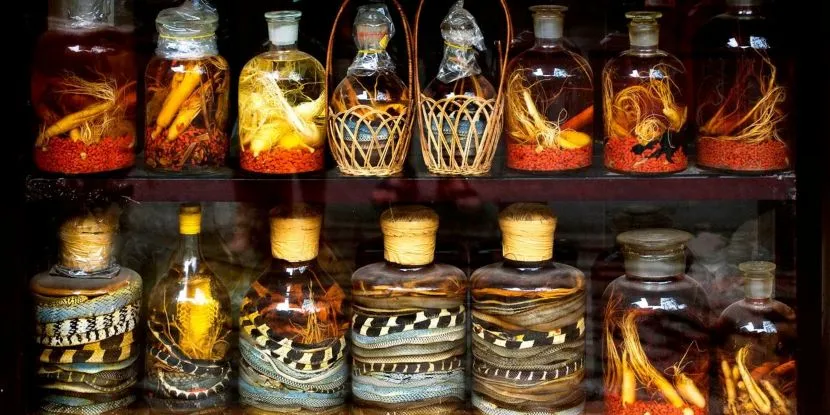
6. Should you try it?
Deciding whether or not to try snake wine is ultimately a personal choice. For many travellers, the intrigue lies in its uniqueness — the visual shock of a coiled snake in a bottle, the folklore surrounding its effects, and the chance to participate in something undeniably different from everyday life. Tasting it can feel like a way to connect with local customs, or to simply step outside your comfort zone while exploring Vietnam or other parts of Southeast Asia.
I’ve tried snake wine once — not for the taste, but for the experience. It was during a meal in a northern Vietnamese village, where a small shot glass was offered with a quiet ceremony. The liquid was golden, almost oily, with the coiled snake clearly visible in the jar behind it. I took a sip. It was strong, almost medicinal, with a sharp edge that lingered. Not pleasant, not terrible, but unmistakably different.
What struck me most wasn’t the drink itself, but how it was presented. This wasn’t a party trick or a tourist performance. It was offered as a gesture of warm welcome from the host, and with a firm belief in its benefits — strength, circulation, vitality. Whether those claims hold scientific weight or not, the belief behind them felt genuine. At that moment, it was more than a drink. It was a piece of tradition handed to me in a glass.
That said, trying snake wine isn’t something I’d recommend lightly. It depends on where you travel to, how it’s made, and how you feel about what’s in the bottle. Some versions are safely prepared and steeped in high-proof alcohol. Others of unknown origin, can be poorly made, with questionable hygiene or additives.
If you do decide to try it, it’s important to choose a reputable source. Avoid unlabeled bottles or street stalls where hygiene and preparation standards are unclear. A small sip is the norm — it’s rarely consumed in large quantities. And if you have allergies, sensitivities, or concerns about bloodborne illness, it may be wise to observe rather than participate. Being more cautious when trying the versions containing fresh snake blood or bile.
Whether you taste it or not, understanding its background and the beliefs behind it can be just as enriching — offering insight into a complex intersection of tradition, medicine, and identity.
Snake wine, a drink steeped in culture and tradition, offers a unique blend of medicinal value and an adventurous flavor. While it holds historical and symbolic significance, safety must be the top priority due to potential risks like contamination or improperly handled snakes. Always try it from reputable vendors and strictly follow all storage guidelines. If you want to experience a more fascinating tradition responsibly and authentically as part of your Asian adventure, don’t forget to follow IZITOUR.
See more:










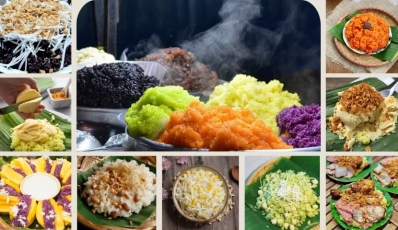










 TRAVELERS' CHOICE 2025
TRAVELERS' CHOICE 2025 